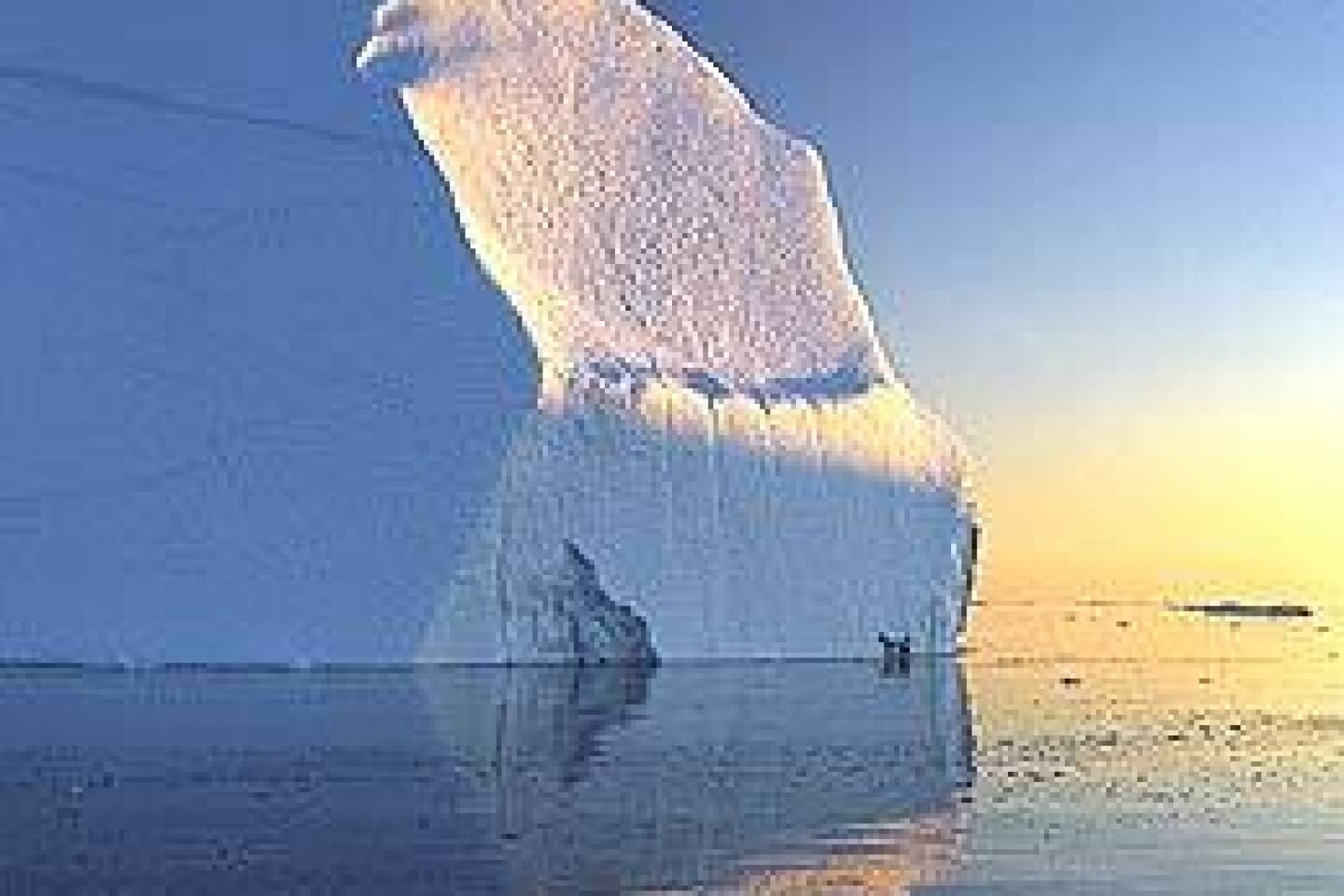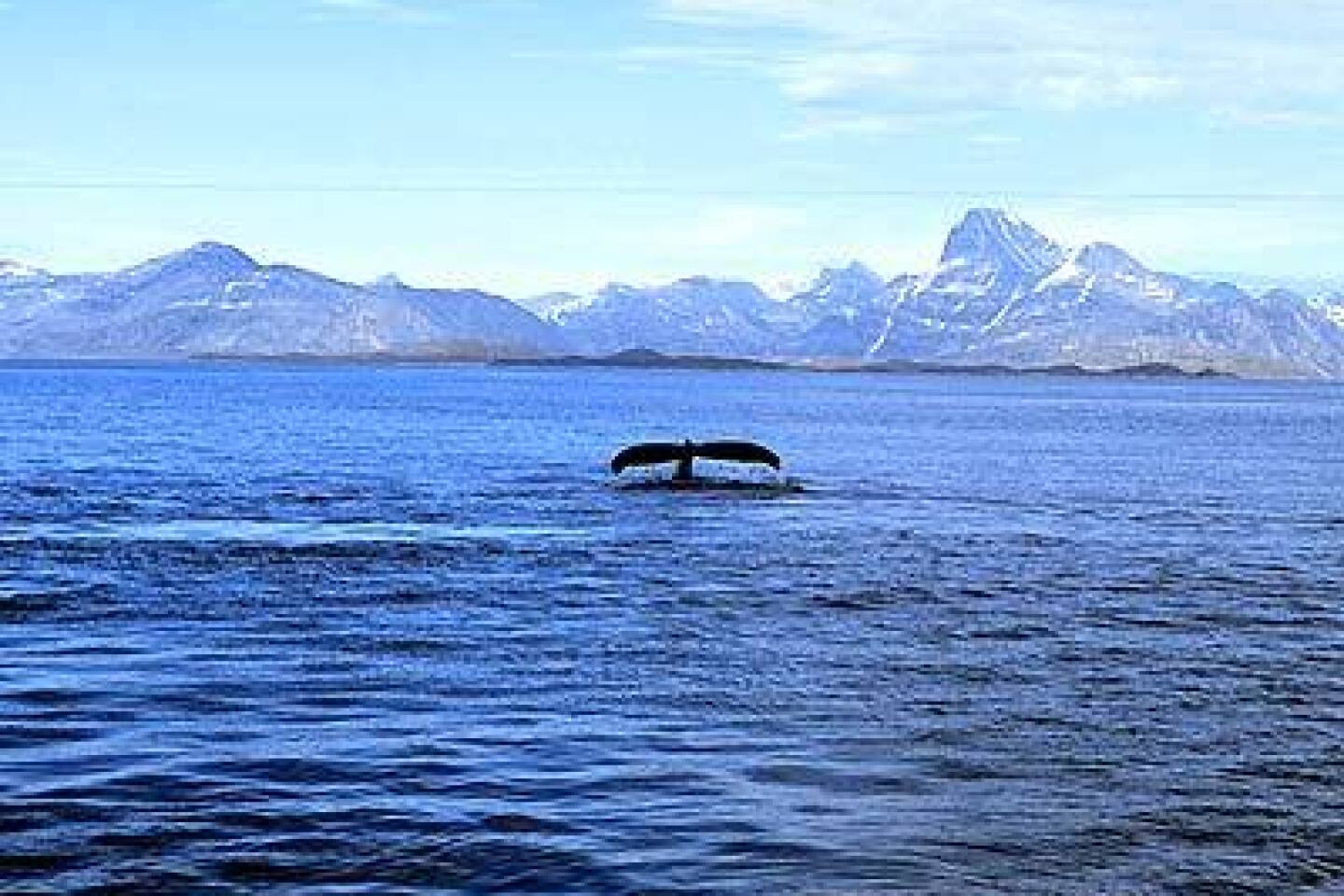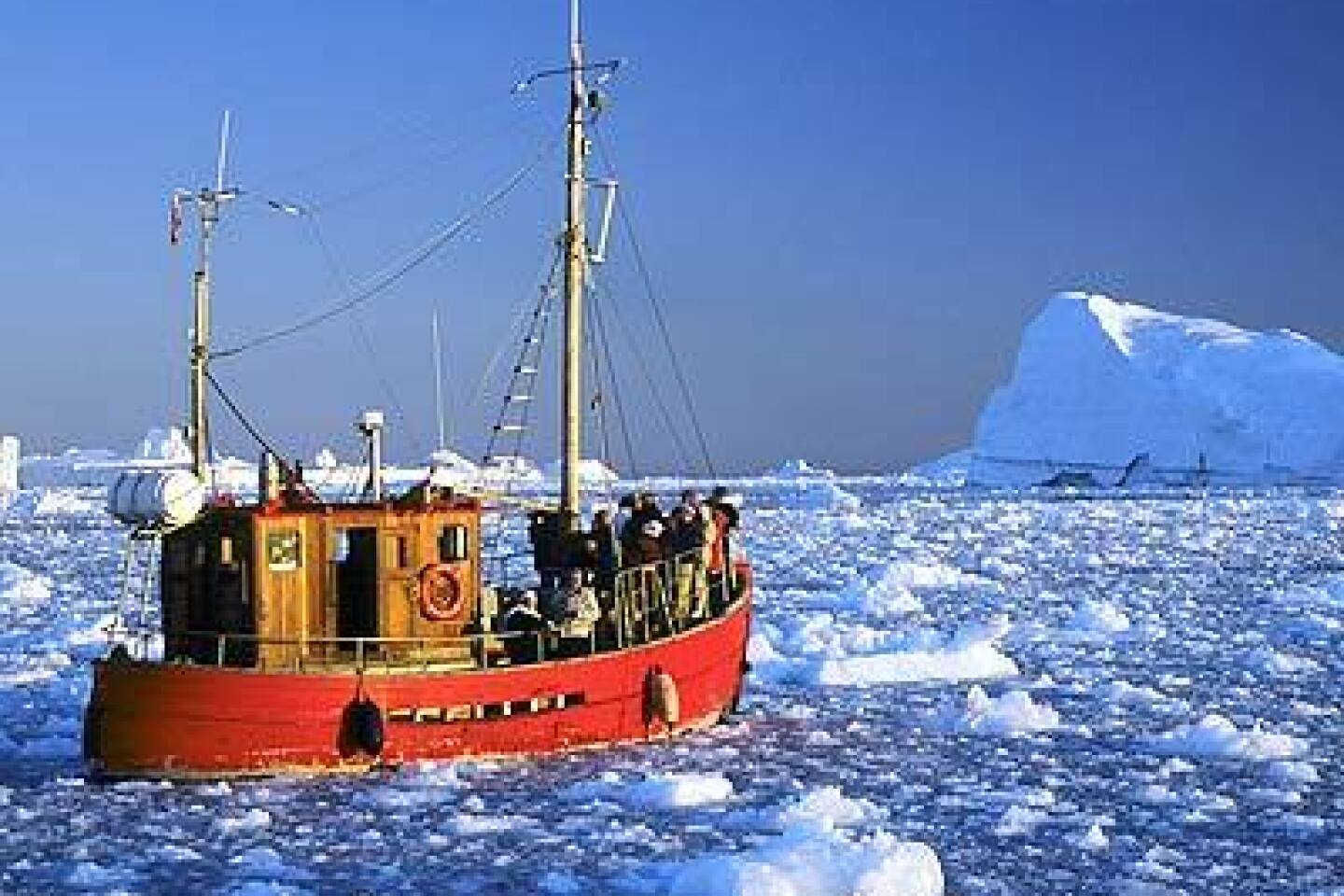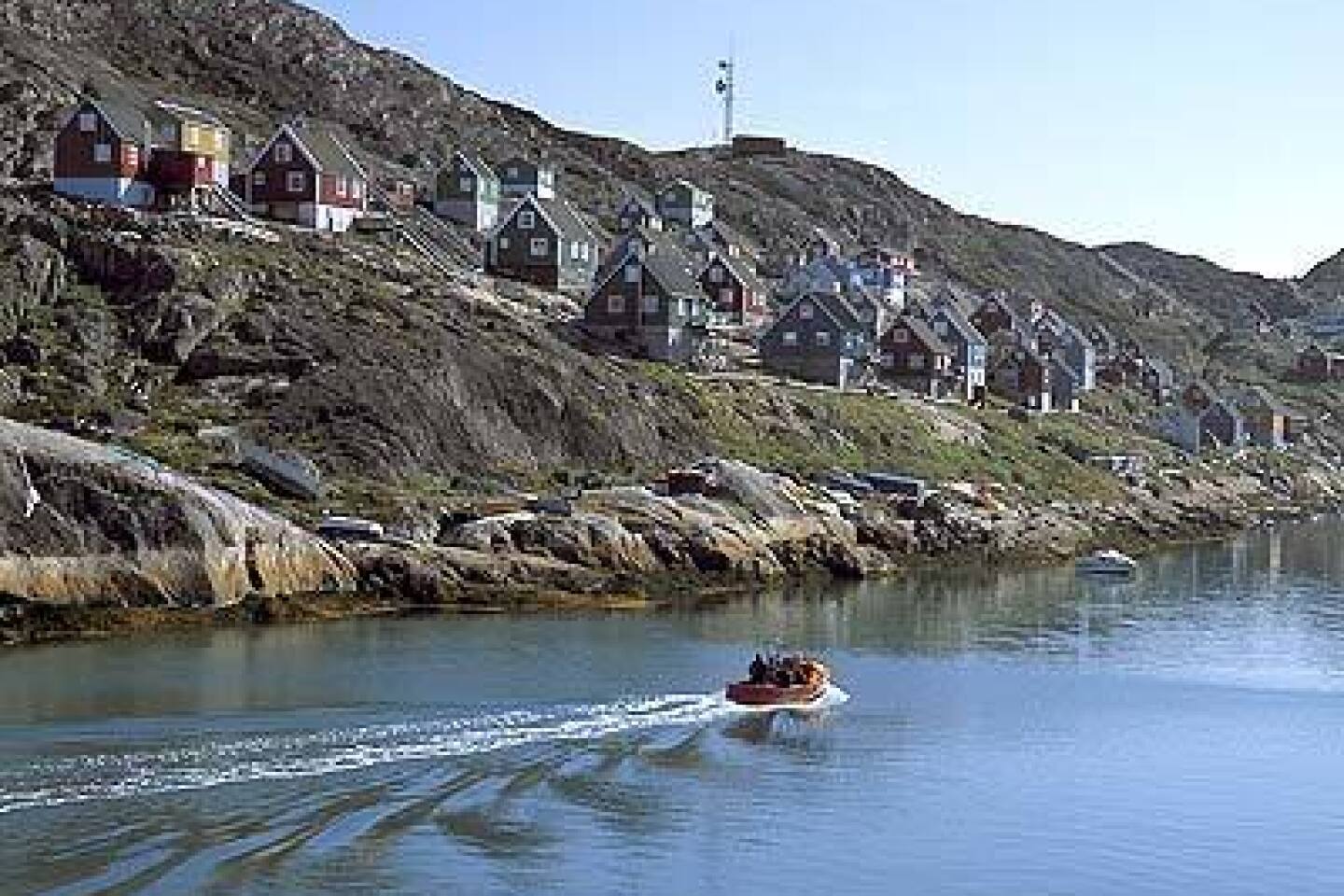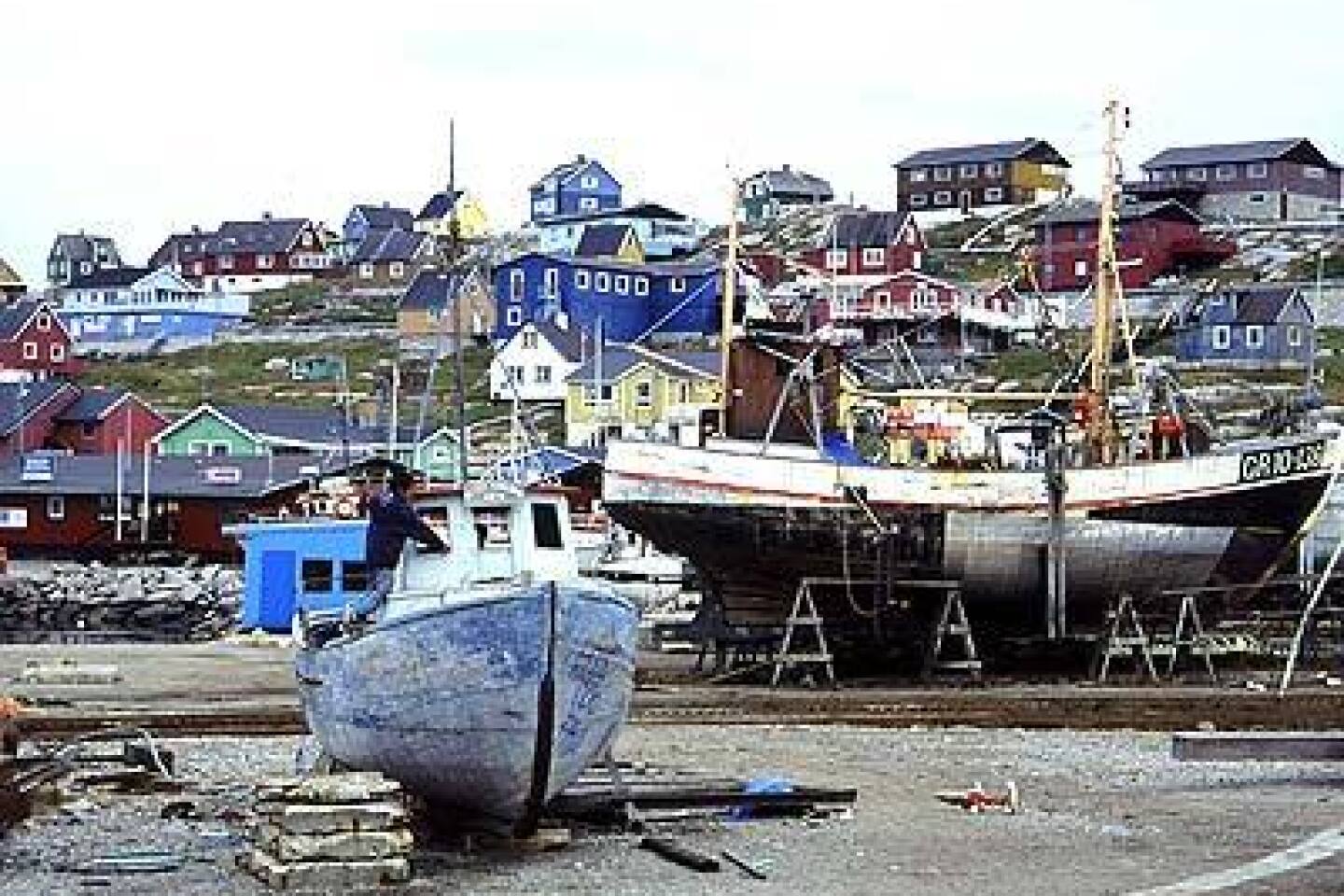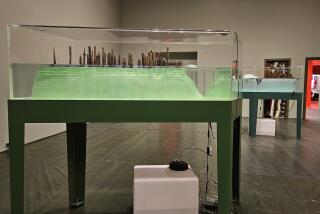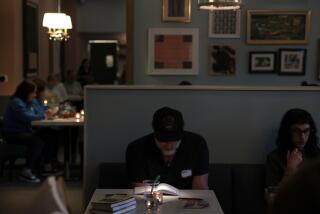Civilization on Ice
Terra incognita is no more. Assumptions about faraway places are easy and plausible in this shrinking, digital world. From a book or a photograph, we can construe the habits of a people; from a movie or a download, we consider them neighbors. Yet as the plane rose above the fog that midsummer morning, flying northeast into the sun, I had no notion of what lay ahead.
The treeless barrens of Baffin Island, its russet and brown tundra patterned by snow and ice, streams and ponds, gave way to the Cumberland Sound. Somewhere over the Davis Strait, the narrow stretch of water separating Canada and Greenland, we crossed the Arctic Circle. Twenty thousand feet below, icebergs spread like stars across the dark water.
Sunlight angled through the cabin. My wife, Margie, and I—and couples from Illinois, Ohio and Iqaluit, Canada—shared a thermos of coffee, and at 8:20 a.m. we dropped into turbulence and clouds. The town of Aasiaat rushed up to meet us.
Greenland, which sits at the top of the Atlantic, is seldom dignified by mapmakers, who glaze it with white and move on without citing its villages or capturing the convolutions of its coast, its broad glacial expanses. Getting here is not simple or cheap, and popular knowledge is often wanting. When I mentioned our plans to friends, I was either reminded, “Iceland is green and Greenland is ice,” or asked seriously, “Do people really live there?”
Yet Greenland, with a population of 56,000, nominally part of Denmark but with its own parliament, is trying to step onto the world stage. Travel brochures—there is a national tourist board—play up such eco-adventures as sea kayaking, trekking and dog sledding across magnificent icescapes. But beyond that, what is this Kalaallit Nunaat, as it is known among its native Inuit—this “land of the people”?
That first afternoon we wandered the streets of Aasiaat, a scattering of homes that were painted blue or red or yellow with white trim and reminded us of Legos. Staying clear of the speeding cars and taxis, climbing stairs up rocky hillsides, I thought about the people who first came here, more than 4,500 years ago. Descendants of the ancient wanderers who crossed the Bering land bridge, they migrated across northern Canada searching for food and for refuge from hostile tribes, and they stopped and they stayed despite the darkness of winter, the cold and hardship.
If all great adventures begin with a sense of mystery and end with a sense of wonder, then, I would discover, there is little difference between the first settlers and the visitors of today.
We had worked out an itinerary with the help of the Great Canadian Travel Co. Although there are cruise ships from the East Coast and flights from Copenhagen and Reykjavik, we chose a different route. We flew instead from Ottawa to Iqaluit and from Iqaluit to Aasiaat in a 13-seat turbo-prop that Great Canadian charters from Air Nunavut in July and August.
Booking cabins on the ferries that run along the coast, we traveled from Aasiaat and Ilulissat in Disko Bay to Sisimiut and the capital Nuuk and back, a round trip of about 750 miles. We stayed in Seamen’s Homes, Lutheran-run way stations for sailors and fishermen that double as clean and comfortable hotels for tourists like ourselves. Our only concession to luxury was a hotel in Ilulissat.
And for 16 days, the west coast of this magnificent island, this inverted teardrop of ice, slowly opened up—a land of open-air fish markets, sled dogs and never-ending light, of cellphones, hip-hop and words with more syllables than we’d ever heard before. Each moment, each encounter came to us like the bright beads that elaborate the native dress, kalaallisuut. Only in time did we learn to read their rich and complex pattern.
Wearing a Nike cap and smoking Kings unfiltered cigarettes, Jakob Knudson helped us carry our kayaks down to the water and launched us. Sitting on top of the water wobbling from side to side was scary at first, but we soon got the knack.
Paddling down a channel southwest of Aasiaat, passing the remnant of an American World War II base, we settled into a graceful rhythm. Clouds grayed the sky; wind-driven chop broke over our bows. Knudson had strapped three thermoses to the front of his kayak. One was filled with tea, one with coffee, and the third held tea with plenty of sugar. Just what’s needed to get our hearts started, he told us, should we capsize.
Days earlier, we had visited the national museum in Nuuk and stood before an exhibit of amulets that had belonged to an Inuit hunter. There were almost two dozen of them, abstract objects of stone, wood and bone. One provided protection against shortness of breath; another, buoyancy. One ensured good fortune when hunting seals and a long life for one’s brother. Another prevented capsizing.
“You all know what an ashtray looks like, right?”
Mikkel Nielsen has been a tour guide to the Ilulissat Ice Fiord for four of his 29 years, and tonight we were headed out on a red-hulled trawler, the Else, for a midnight excursion to this landmark. Books devote pages to Greenland’s ice cap, but Nielsen had stumbled on a very simple analogy: “Imagine filling the ashtray with sugar until the sugar pours out of the notches where the cigarettes go.”
The most defining—and the most imperiled—aspect of Greenland is its inland ice, which covers more than 80% of the island. Almost 10% of it flows through a ring of mountains, like sugar out of Nielsen’s ashtray, into the Ilulissat Ice Fiord. But more significant than the volume is the speed—60 feet a day. As it advances, it calves icebergs the size of small islands that drift seaward until they run aground on a shallow shelf just offshore. Few natural processes on the planet are as impressive as what occurs here, and there is no better time to see it than in summer at midnight, when the nearly setting sun gilds the icy faces.
Torvald Jensen is the captain of the Else. He sat in the wheelhouse wearing a red cap, burgundy sweater and green bandanna, his beard long and gray. A native of Denmark, Jensen has lived in Greenland for 30 years, and at 70 today, isn’t about to leave. “The most beautiful place in the world,” he’ll tell you, but he worries about its changing. “We used to have ice in the winter through May,” he said. Last year he set out in February, the year before in January.
At the mouth of the fiord, the ocean was the consistency of thick slush. A chill rose from the water. Fall overboard and you freeze, 20 minutes tops. The hull creaked and shuddered as it shouldered aside Cadillac-size chunks of ice.
Tonight Jensen’s charges were off the French cruise ship Le Diamant, anchored just outside the Ilulissat harbor. “C’est magnifique!” the couple next to us exclaimed. “Ooh-la-la.” Jensen killed the engine, and the silence stunned us as these Everests, these Notre Dames, these Gehry-esque creations cast long shadows across the sea. A crew member poured Champagne while the light turned from blue to magenta and emerald green.
We heard a roar like the crash of industrial equipment. We stared out across the bay and saw a plume rising from a slab of ice that had suddenly sheared off a berg and was sliding into the water, sending a wave purling outward. Fifteen minutes later, the Else started to rock. Jensen keyed the engine. It was about 1:30 a.m. when we returned to the harbor. As the sun skirted the horizon, a half moon rose in the east.
“I don’t like him much.” Our guide, Konrad Seblon, surprised us during our walking tour of Ilulissat by breaking from the script. We were in the Zions Kirken, standing before a painting of Hans Egede, the man who brought Lutheranism to Greenland in 1721. “He destroyed a lot of Inuit culture,” Seblon explained. “Many drums and many traditions.”
Egede, searching for a lost colony of Vikings, found nothing but a frozen wilderness, and still he stayed. Three hundred years later, he haunts the Inuit. Most Greenlanders have Danish names—intermarriage was encouraged as a means of assimilation—but not everyone identifies with the Danes. At 28, Seblon is proud of his Inuit heritage yet easily cops to Western cool. He wears glasses with clip-ons, Nike Air sneakers and cargo pants. Last summer he took a trip to the south of France, but stayed for only four months. Too hot, he said, and the girls there didn’t compare to the girls here.
Like most churches in Greenland, this one has walls of robin’s-egg blue and candelabra hanging from the ceiling. On the altar is a painting of Christ rising from the sepulcher in his burial wraps. But who was this man, I wondered, this fisherman from Galilee, to the Inuit, whose shamans taught them about Sila, the baby giant who represents both weather and consciousness, and Nerrivik, the orphan who sank to the bottom of the ocean and embodies its fury and capriciousness?
Today people are resuming their Greenlandic names, Seblon told us, and trying to keep their culture alive—kayaking, drum dancing and dog sledding. Seblon has 18 dogs and races them in the winter in Ilulissat. As we walked back through the town, fog from the fiord wafting through the morning sun, he waved to friends who passed him on the street, in cars and cabs.
World War II and the Cold War opened the Arctic to the world. Strategically valuable, these icy lands, the province of stiff-lipped explorers, became home to soldiers. There were once 14 American Army bases on west Greenland (Jack Kerouac was stationed here), and with America came Juicy Fruit, Sears Roebuck, kerosene, radio broadcasts, country music. The beat continues. At 10:30 on a Wednesday morning, the Ilulissat fish market was filled with men and women haggling with fishermen and hunters for whale and seal meat, reindeer and musk ox, while a kid with a pierced nose and a blond mohawk practiced spinning his skateboard.
Four days later, we visited Sisimiut and perhaps the only open-air swimming pool north of the Arctic Circle. It was a cold and rainy day; steep mountains had trapped the gray clouds. Steam rose from the blue, blue water that reeked of chlorine. There were 25 kids running around, falling off inflatable toys, cannon-balling one another. A small poolside stereo speaker was wrapped in a plastic shopping bag that billowed out and in from the percussion of the woofer and Eminem’s Slim Shady.
Three days later still, we turned on the television in Nuuk and watched an interview with Colin Powell, who was visiting Denmark. Whenever Greenlanders question the colonization of their country 300 years ago, they tell themselves, “Better the Danes than the Americans.” The forced relocation of Inuit hunters and their families in 1953 to make way for the Air Force base at Thule still burns.
Nothing you read can prepare you for the sight of icebergs at sea. Our ferry was the Sarpik Ittuk, and as it droned across Disko Bay, these ghostly islands with their own wave-crashed shorelines, canyons, plateaus and waterfalls drifted by, glittering and melting in the hazy sun.
Arctic terns coursed over our stern wake. We sailed beneath a mackerel sky. Disko Island lay ahead, with its broad escarpments angling down to the sea and its mist-filled valleys leading up to the glaciers that cover the mountains like clouds. To contemplate such vistas is to peer back in time and know what Greenland means to a Greenlander, someone at home in this land where reminders of one’s mortality abound.
We came to look forward to our time aboard the ferries. Wrapped in parkas, caps and scarves, we wandered the deck with our cameras and binoculars or lounged in teak chairs on the fantail, and when we got too cold we settled in the cafeteria to write postcards and sample the breads, cheeses, cold cuts, coffee and cinnamon swirls.
But it was the comings and goings at each quay that caught our attention. Here were scenes of such exuberance that we found ourselves mesmerized, hanging over the rail, unabashed voyeurs. The ferry could be miles from docking, but the conversations would start on deck by cellphone and shift into an arm-flailing pantomime once the dock came into sight.
We stopped in a village at midnight and could never have imagined such a carnival: 24 idling cars, children running in circles, the smell of tobacco smoke, the flash from a camera, a soccer team (in green jackets) smiling, horns blaring, shouting, backpackers (mostly Europeans) with trekking poles, kids taking turns spinning a basketball on their fingers, mountains of boxes and stacks of luggage. Bruegel would have painted this, the streams of people moving around one another like currents of water.
Beneath another gray sky, in an archipelago of rocky islands, Nuuk was a line of white buildings shadowed by crags, most notably the broken peak of Sermitsiaq. The ferry approached at 6 a.m., and as we stood on the deck we wondered—after the natural splendors of the north—what this city might have to offer. The Lonely Planet guide was not inspiring: “Nuuk may be fascinating for politicians, businesspeople and social anthropologists . . . but otherwise, the worthwhile sights can be covered in one day.”
With a population of 15,000, Nuuk is a Wild West town, the capital the country wishes it didn’t need. On a sunny Friday afternoon, the main drag—a short pedestrian strip with a bank, a library, a market—was crowded with prams and bikes, kids with dogs on leashes, parents greeting one another. A woman strummed “Jambalaya” on a guitar. Sidewalk vendors spread out bootleg videos, cuts of caribou, jewelry, and overhead a construction crane cast a long shadow on a new office building.
“Up north, Nuuk is not considered part of Greenland,” said Gitte Nestel. “But, of course, it is. We would like to keep the notion of the romantic Inuit, but things are changing. If you want home rule, you must have a capital in order to survive.” Nestel is a co-owner of Nipisa, a restaurant in Nuuk that is perhaps the best reason to put the city on any itinerary.
We had spent the day playing tourist in the colonial harbor where Hans Egede first planted the cross, wandering through a huge indoor swimming pool complex and looking at an art exhibit in the Katuaq Cultural Center, a magnificent building that features a movie theater (playing “Garfield,” “50 First Dates” and “I, Robot”) and a Euro-cool cafe (“Californication” in the background).
Our reservation at Nipisa was for 7:30, and by the time we arrived the restaurant was full, the tables set with candles, crystal and long-stemmed roses. For three hours, we enjoyed a sumptuous dinner featuring fillet of smoked musk ox with pesto sauce, salmon tartare and fried halibut with mango chutney, tenderloins of reindeer and musk ox with turnips, onions and red currants in a truffle sauce, and crème brûlée with German blueberries and Belgian strawberries.
Nestel owns the restaurant with her partner, Rune Collin, both 31. They opened Nipisa eight years ago and haven’t seen anything less than a full house since. Nestel met Collin while she was working in a restaurant in Denmark and agreed to visit Greenland with him for six months. The formula for Nipisa, named for a fish found in cold northern waters, was simple: Call it Greenland nouvelle cuisine.
Once, Nestel told us, there were no restaurants in Nuuk that served Greenlandic food; everything was imported. “They weren’t even using the fresh fish,” she said. “Our goal was to open people’s eyes to Greenlandic raw materials as delicacies.” Staples are either flown or shipped from Denmark, logistics that require both weekly and monthly planning.
And Nestel visits the local markets every afternoon. “I see myself as a Dane,” she said, “but I see my home as Greenland.”
A grassy promontory protects a small bay outside of Aasiaat. Jakob Knudson guided us there in our kayaks, and by chance we met a family picnicking on this Sunday afternoon. Mother was cooking seal for her four children. She had cleared the ground of peat and constructed a three-sided stone oven and was feeding the flames with moist heather, which threw off thick white smoke and kept the mosquitoes away. (Found everywhere in the Arctic, Aedes nigripes rises in swarms from the bogs during milder summer moments and is well-known for its appetite.) The children’s faces were greasy from the meat, and after dinner they scavenged for blueberries. Nearby were the remains of a peat house, nearly a century old. We sat downwind of the fire. Knudson poured coffee.
Mother came over with her youngest daughter and introduced herself as Lone Zethsen and her 3-year-old as Ane-Kathrine. She invited us to her home that evening for dessert. The family lived on the edge of town in a blue two-story apartment house that smelled of fish.
She opened the doors and welcomed us in. We took off our shoes—it’s a custom—and hung up our jackets. Zethsen’s husband was sitting on the hardwood floor with Ane-Kathrine watching a DVD about polar bear hunting on a new Sharp flat-screen TV. Margie and I joined Zethsen on the sofa. She served us coffee and tea, cookies and cakes on china unpacked for the occasion. In broken English, she told us about her correspondence with pen pals around the world. She showed us a box of letters, photographs and stamps, and confessed that her favorite video is Eddie Murphy’s “Daddy Day Care” and that she really, really likes Tina Turner.
Then she told us something of her past. She was born on Disko Island, in the coal-mining town of Qullissat. Qullissat thrived for 50 years, until one day—as the story goes—a Danish bureaucrat shut it down with the stroke of a pen. Today, she said, it’s a ghost town. Her grandfather is buried there. Qullissat, she said, is best known for its regional music—vaigat, a cross between country-western and polka, sung in Greenlandic. Zethsen put on a DVD featuring a performance of vaigat and tried to hide her tears.
Near the end of our 16 days, we took a boat out of the harbor at Nuuk. It was a cold, windy day. A necklace of small islands glistened in the afternoon light, and there, near a small cove, we glimpsed a spout, and then another—a superfine mist that lingered like a cloud, a bloom drifting in the wind—and for the next hour we lost ourselves tracking three humpback whales, each about 45 feet long.
We listened, then heard the explosion of air and then the wheezing, the quick sucking-in. We watched the long black backs, notched and finned like sea serpents, rolling and arcing and cutting across the surface. Then came the descent, a sounding so precipitous that just seconds later, after their arched backs disappeared, their white-mottled flukes broke the surface, and they were gone.
What can Greenland teach the world?
It was a question I posed to Ono Fleischer. We were aboard a 36-foot cabin cruiser, doing 16 knots on the way back to Ilulissat. Fleischer is a legend among Greenlanders, a modern-day Knud Rasmussen. From 1975 to 2001, he periodically staged dog-sledding expeditions throughout the Arctic to unite the circumpolar Inuit (about 150,000 people) and remind them of their common customs and culture. Today, at 56, he has a pacemaker and drives boats instead of sleds.
We were returning from a day trip to a glacier, three hours north of Ilulissat and one of the more spectacular walls of ice in Disko Bay. After a lavish lunch in a hillside cabin opposite the glacier—smoked halibut with dill, mackerel in tomato sauce, liverwurst, beets, red cabbage, pâté with bacon, boiled eggs, pickles, pepper ham, salami, bologna, herring with onion, tuna salad and dried onion—we escaped the swarms of mosquitoes and headed out into the icy slush of the bay.
Fleischer wore tinted glasses. Brown eyes, brown complexion, graying goatee. A North Face fleece kept him warm. On the way home, two bungee cords held the twin throttles forward as we plowed ahead.
What can Greenland teach the rest of the world?
“How to wait,” he said. “The Inuit people can wait. Danes ask questions. Instead it is best to look and to think. If we were to break down here in the fog, these people,” he pointed to his passengers, “the Germans, the Danish, wouldn’t know what to do. We’d go below. Have some tea and something to eat before acting.”
As the fog thickened, Fleischer unstrapped the throttles. The long, treeless fiords, the vertical cliffs of granite and schist, slowly disappeared.
“Nature is so hard in this area that we must wait. People think we’re crazy for waiting. But our civilization goes very, very slowly. People in cities are very, very busy. That’s the difference—the big difference between them and us.”
*
GUIDEBOOK
Flowing With the Icebergs in Greenland
Telephone numbers and prices: The country code for Greenland is 299. The currency of Greenland is the Danish krone. All prices are in U.S. dollars and calculated at an exchange rate of 5.77 kroner to $1. Hotel rates are for a double for one night. Food prices are per person.Getting there: From LAX, connecting service (change of plane) to Copenhagen, Denmark, is offered on Air France, British Airways, KLM, United and American. From Copenhagen, Air Greenland flies to Kangerlussuaq and then to Nuuk. From LAX, connecting service to Reykjavik, Iceland, is offered on America West and American. From Reykjavik, Air Iceland flies to Kulusuk, Greenland, and from Kulusuk Air Greenland flies to Nuuk.Tour companies: Most travel agencies booking excursions to Greenland use Iceland as a point of departure, including: The Great Canadian Travel Co. Ltd., (204) 949-0199 or (800) 661-3830, https://www.greatcanadiantravel.com . Iceland Saga Travel, (508) 825-9292, fax (508) 825-9933, https://www.icelandsagatravel.com . Scantours, (310) 636-4656, fax (310) 390-0493, https://www.scantours.com . Icelandair Holidays, (800) 779-2899, fax (410) 715-5134, https://www.icelandairholidays.com .
Getting around: By air: Air Greenland, 34-34-34, https://www.airgreenland.gl . By ferry: Arctic Umiaq Line, 34-99-00, https://www.aul.gl .
Where to stay in Aasiaat: The Seamen’s Home, P.O. Box 216; 89-27-11, fax 89-29-10. Rates from $160 a night.
Where to stay in Sisimiut: The Seamen’s Home, P.O. Box 1015; 86-41-50, fax 86-57-91. Rates from $160 a night.
Where to stay in Nuuk: The Seamen’s Home, P.O. Box 1021; 32-10-29, fax 32-21-04. Rates from $180 a night.
The website for the Seamen’s Home is https://www.soemandshjem.gl .
Where to stay in Ilulissat: Hotel Arctic Ilulissat, P.O. Box 1501; 94-41-53, fax 94-40-49, or e-mail [email protected]. Rates from $250 a night, including breakfast and local transportation.
Where to eat in Ilulissat: Takanna at the Hotel Arctic offers casual fare ranging from burgers and pasta to steaks and fish. From $15.
For a more formal dining experience, Restaurant Ulo at the Hotel Arctic has three- to five-course meals ranging from grilled catfish to fillet of reindeer. From $62.
Where to eat in Sisimiut: Misigisaq, Jensenip Aqquserna, Sisimiut Havn; 86-38-88, fax 86-38-38, https://www.misigisaq.gl . Known for its unique mix of Chinese cooking and Greenlandic ingredients, featuring Greenlandic sushi or whale cooked in a Sichuan sauce. From $10.
Kafè & Art Ukiivik, Aqqusinersuaq 67, P.O. Box 454; 86-36-37, or e-mail [email protected]. The only espresso machine in town fell into the right hands. Meals are simple and delicious—pasta, soup, sandwiches with smoked salmon and reindeer stew. From $10.
Where to eat in Nuuk: Nipisa, Aqqusinersuaq 6, P.O. Box 337; 32-12-10, https://www.nipisa.com . If Michelin went to Greenland, this restaurant might just earn three stars for its cuisine, service and an extensive wine list. From $33.
Katuaq Gronlands Kulturhus, Imaneq 21, P.O. Box 1622, Gronland; 32-33-00. For sandwiches and soups, coffee and cakes.
For more information: Greenland Tourism (the national tourist board of Greenland), P.O. Box 1139, Strandgade 91, DK-1010 Copenhagen K, Denmark; (45) 32-83-38-80, www.greenland.com.
More to Read
Sign up for The Wild
We’ll help you find the best places to hike, bike and run, as well as the perfect silent spots for meditation and yoga.
You may occasionally receive promotional content from the Los Angeles Times.
